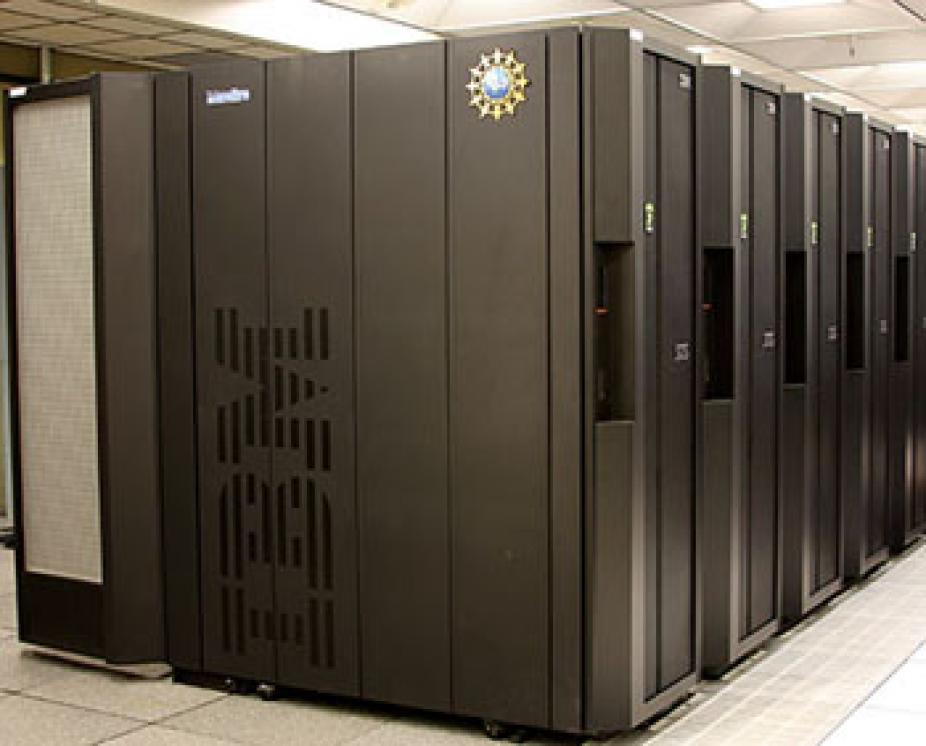IBM p6-p575 - Bluefire

IBM
In use: April 24, 2008 - January 31, 2013
Production use
Peak teraflops: 77.00
Processors: 4,096
Clock speed: 4.70GHz
Memory (terabytes): 12.22TB
Electrical power consumption: 538.20 kW
NCAR took delivery of a new IBM supercomputer on April 24, 2008. The supercomputer, a Power 575 Hydro-Cluster named "Bluefire," was the first of a highly energy-efficient class of IBM machines to be shipped anywhere in the world. Jobs first ran on Bluefire on May 30, 2008. It was placed into full production service on July 1, 2008, removed from user production service on February 1, 2013, and decommissioned two weeks later.
Scientists at NCAR and across the country used Bluefire to accelerate research into climate change, including future patterns of precipitation and drought around the world, changes to agriculture and growing seasons, and the complex influence of global warming on hurricanes.
Bluefire's computing power helped scientists create the first-ever comprehensive computer model of sunspots. Researchers also used the system to improve weather forecasting models, enabling society to better anticipate where and when dangerous storms are most likely to strike. Each year Bluefire provided numerous opportunities for studying challenging problems, including projects related to snowfall and snowpack predictions, climate change simulations for use in water resource adaptation planning, ocean conditions, and unfolding natural disasters.
Researchers using Bluefire generated climate simulations needed for the fifth report on global warming by the Intergovernmental Panel on Climate Change (IPCC), which conducts detailed assessments under the auspices of the United Nations. The IPCC was a recipient of the 2007 Nobel Peace Prize. Some of Bluefire's capacity was dedicated to the Antarctic Mesoscale Prediction System for operational weather forecasting in support of the NSF’s Office of Polar Programs.
As the primary production system for the Climate Simulation Laboratory and the NCAR/UCAR user community, Bluefire proved to be a reliable and efficient computational platform.
Bluefire had a peak speed of more than 77 teraflops (77 trillion floating-point operations per second), replacing three supercomputers that together had an aggregate peak speed of 19 teraflops. It also more than tripled NCAR's sustained computing capacity when it became fully operational. For a time, Bluefire ranked among the 50 most powerful supercomputers in the world.
Bluefire housed the POWER6 microprocessor, which featured a clock speed of 4.7 gigahertz. The POWER6 chip supported simultaneous multithreading, which increased the speed of many applications run at NCAR by approximately 20%. The Bluefire system comprised 4,064 processors in 128 Power 575 nodes. Each node contained four dual-chip modules, each of which contained eight POWER6 processor cores. The system featured more than 12 terabytes of memory, an eight-plane DDR InfiniBand interconnect, and 150 terabytes of IBM FAStT DS4800 disk storage. The disk capacity available to Bluefire users increased to 1.6 petabytes with the deployment of the initial implementation of NCAR's GLADE shared disk resource in August 2010.
Bluefire relied on a unique, water-based cooling system that was 33 percent more energy efficient than earlier air-cooled systems. Heat was removed from the electronics by water-chilled copper plates mounted in direct contact with each POWER6 microprocessor chip. As a result of this water-cooled system and POWER6 efficiencies, Bluefire was three times more energy efficient per rack than its predecessor.
Over its lifetime, Bluefire delivered more 162 million core-hours to its users by running more than 7.3 million individual jobs over its 1,677 days of production service. It had an average lifetime utilization of 76% and its overall availability was just over 97%.